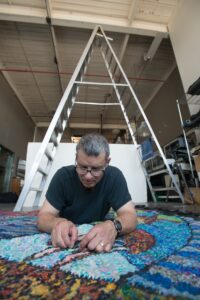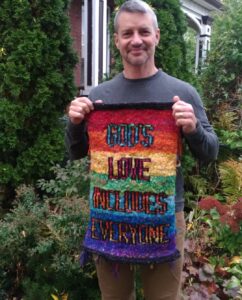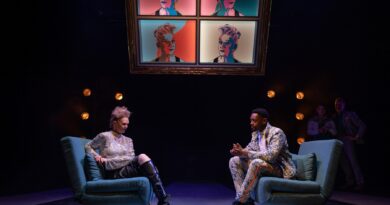Kirk Dunn’s “The Knitting Pilgrim” arrives after a 15-year inter-faith journey

A talent born from a benign rivalry has spawned a description-defying solo show that is catalyzing conversations and inspiring empathy across Ontario. Kirk Dunn’s The Knitting Pilgrim is a multidisciplinary theatrical experience that interweaves storytelling, image projection and a one-of-a-kind textile installation called Stitched Glass. Stitched Glass is a triptych of large hand-knitted tapestries, designed in the style of stained-glass windows, which form the show’s set. More than 90 pounds of knitting, the tapestries explore the commonalities and conflicts among the Abrahamic faiths: Judaism, Christianity and Islam.
The Knitting Pilgrim is performed solo by Dunn. This unique and surprising show was co-written with his wife Claire Ross Dunn, and is directed by Jennifer Tarver. And Dunn designed and knitted every intricate stitch of the stitched glass that forms the show’s backdrop. He conceived the Stitched Glass tapestries after Nataley Nagy, past Executive Director of the Textile Museum of Canada (and now the Executive Director of the Kelowna Art Gallery) encouraged him to pursue exhibition art. “Nataley had seen my work designing sweaters, and felt I should be moving toward creating installations,” Dunn recalls.
This was shortly after 9/11, and as a “PK (preacher’s kid)”, Dunn found himself struggling with the contentious relationship among Judaism, Christianity, and Islam. He knew that the three religions share the same root, and are grounded in faith in one God, social justice, and the return of good for ill. At the same time, a significant disconnect was evident. So “I decided to explore the commonalities and the conflicts of the three faiths by pulling the medieval art form of stained glass into the present, and combining it with the accessible craft of knitting – and by employing these two art forms – that ironically don’t use words – to provoke a conversation of nuance and colour about how the faiths are relating to one another.” The work was at once an external response to Nagy’s creative prompt and an internal response to what Dunn saw happening in the world around him.

But how did Dunn become such a skilled and prolific knitter – and how do knitting and acting intersect in the first place? Fresh out of theatre school, Dunn’s first acting job was a children’s theatre tour of a play about gender equity for the Ontario Women’s Directorate called Girls Can, Boys Can by Toronto playwright Dolly Reisman. “In the play, my relationship with my acting partner – a talented female actor – was very much ‘anything you can do, I can do’. We extrapolated this into our friendship off-stage as well.” So during the tour, if Dunn would get up at 7:00 AM to swim in Lake Superior, then so would she. And when Dunn found out that she could knit . . . “well, if she could knit, then so could I!” Dunn’s girlfriend at the time had just knit him a sweater, so he figured a big surprise would be if he knit her a sweater in return. Which he did. As it turns out, the girlfriend didn’t last, but the habit of knitting did. As his early career progressed, he found himself with a lot of time backstage, at auditions, or on set, sitting around and . . . waiting. “The knitting was a fabulous way to pass the time, and have something to show for it.”
The Stitched Glass tapestries were intricate and painstaking work. They took Dunn much longer than he had anticipated: 15 years, rather than the 10 months he had pitched in his grant application to the Ontario Arts Council. In fact, “because I had not been trained in the visual arts, had no gallery representing me, and had no other exhibitions under my belt, I wasn’t really recognized by the visual art world, so as I approached the end of my knitting, I wasn’t sure how to get the tapestries seen.” A friend of the Dunns, Tracey Erin Smith (the Artistic Director of Soulo Theatre), suggested that he use the artistic forum he was most familiar with – the theatre – and write a one-man show using the Stitched Glass tapestries as his set. “It was an amazing idea. My wife (who is a writer primarily for TV) and I received a Toronto Arts Council playwriting grant, and wrote a show called The Knitting Pilgrim.”

The Knitting Pilgrim premiered in May to acclaim, and is currently playing at the Toronto Fringe Festival before continuing its provincial tour into the fall. Dunn’s intention in creating the show was to prompt understanding through conversation. He consulted people of Christian, Muslim and Jewish faiths to help him research and design the artwork, and to learn about a wide range of feelings and experiences. Though he has more than achieved his aim in promoting communication and compassion, the show’s resonance with audiences has turned out to be his “biggest surprise”: “I had spent so long on my own, wrapped up in the solitary act of knitting and creating, that the project had lost any sense of novelty for me.” Its long gestation had made it a source of feelings of shame and failure – a commitment that he needed to wrap up for closure. And this was compounded by fear that some of the issues he was dealing with might wind up offending people. “As the script developed – mostly in the 14th of the 15 years of the project – I was pleasantly surprised by the welcoming and enthusiastic response. Finally, people were seeing the tapestries, and they were amazed. And people wanted to engage in conversation about the themes in the tapestries, which are brought to the fore in the play. That, for me, was the most hopeful thing of all – because conversation about interfaith empathy, and a focus on our common thread, was what I had always hoped for.”
In our current divisive climate, The Knitting Pilgrim invites soul-searching and dialogue to awaken critical consciousness, interrogate presumptions and combat a rising tide of xenophobia. And Dunn has three quite specific desires for audiences after experiencing The Knitting Pilgrim. First, he hopes that they leave with a deeper appreciation of how much Judaism, Christianity, and Islam have in common. Second, he wants them to consider critically how they think: “What have they made up their minds about? Do they consider issues from a black-and-white perspective, or can they see the complexity and colour in the conflicts of life?” Lastly, and most personally, he hopes that they will take inspiration from his 15-year creative and spiritual journey: “There were many obstacles to be overcome along the way, not the least of which were fear and self-doubt,” yet he doggedly persevered.

“If there is one thing I’d like to communicate to young people, it is that if something is worth doing, it is likely to be scary, as well. Life is a struggle, and much of it is a struggle with yourself. And that is good.”
News You Can Use
What: The Knitting Pilgrim, written by Kirk Dunn and Claire Ross Dunn; directed by Jennifer Tarver; performed by Kirk Dunn
Who: Audiences 13 years of age and older
When and Where: August 16-19, 2023, Theatre Collingwood, Simcoe Street Theatre
Info and Tickets: theatrecollingwood.ca
© Arpita Ghosal, SesayArts Magazine, 2019; updated July 27, 2023
About The Author
Arpita Ghosal
Arpita Ghosal is a Toronto-based arts writer. She founded Sesaya in 2004 and SesayArts Magazine in 2012.
Visit About Us > Meet the Team to read Arpita’s full bio …




